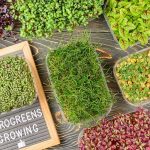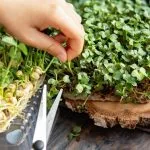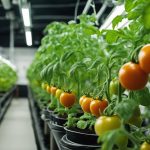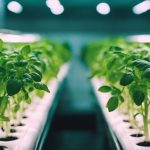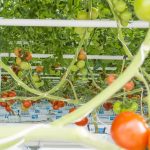Exploring the world of hydroponics opens up a new horizon for gardening enthusiasts like you, who may be looking for an efficient and space-saving way to grow plants. The best plants for hydroponics are those that adapt well to water-based environments, often resulting in faster growth compared to traditional soil gardening. Hydroponic systems provide plants with nutrients directly through water, eliminating the need for soil and often reducing pests and diseases.
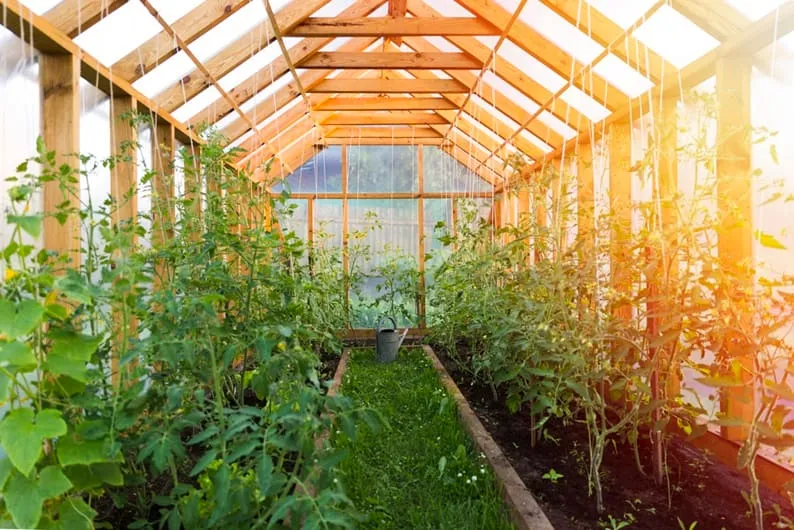
As you delve into hydroponics, you’ll discover a variety of fruits and vegetables well-suited for this method. Leafy greens such as lettuce, spinach, and kale thrive in hydroponic conditions due to their lower nutrient requirements and quick harvest times. Similarly, herbs like basil and mint are excellent choices for your hydroponic garden, offering fresh flavors year-round with minimal maintenance.
Beyond greens, several fruiting plants also perform well in hydroponic setups. Tomatoes, strawberries, and peppers are among the popular options, valued for their consistent quality and the impressive yields that hydroponic methods can facilitate. As you compile your list of hydroponic fruits and vegetables, consider factors such as growth rate, nutrient needs, and space requirements to ensure a bountiful and successful indoor garden.
Best Plants for Hydroponic Beginners
Hydroponic gardening offers you a clean and efficient way to grow your favorites right at home. Here are some of the best plants to start your hydroponic plants at home journey.
Lettuce Varieties
Lettuce is one of the easiest and fastest-growing hydroponic plants, making it perfect for beginners. Varieties like Romaine and Butterhead thrive in hydroponic systems and can often be harvested within a month to six weeks of planting. This quick turnaround makes it ideal for continuous production and frequent harvesting. Its modest nutrient requirements make it easier to manage in a hydroponic system. It can be grown at high densities in hydroponic systems, maximizing yield per square foot, and doesn’t need high-intensity lighting. This is particularly advantageous in vertical farming or other space-limited settings.
Easy Greens and Leafy Vegetables
Besides lettuce, kale, spinach, bok choy, and watercress are highly recommended for your hydroponic garden. These greens flourish in water-based systems and can contribute to a continuous harvest of leafy vegetables.
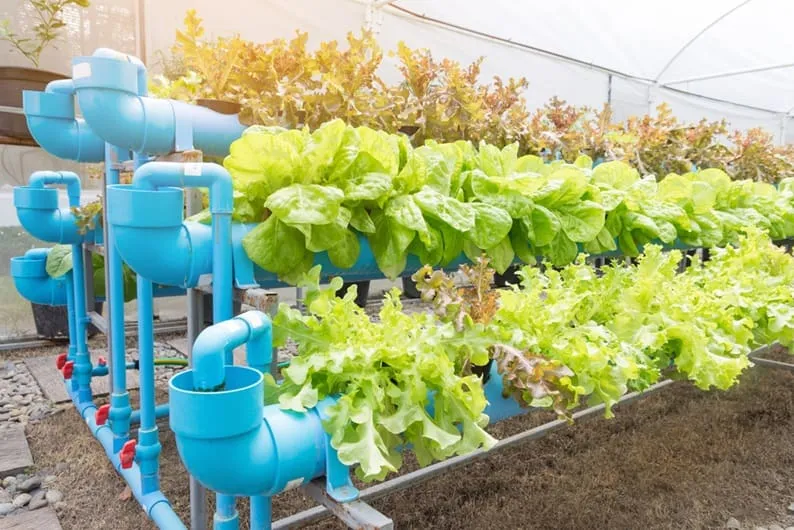
Herb Selections
Herbs such as basil, mint, rosemary, oregano, thyme, and cilantro are excellent for hydroponic cultivation. They grow fast, require less space and can be continuously harvested for your cooking needs. Herbs grown hydroponically are typically cleaner than those grown in soil, as they are not exposed to dirt. This makes them more convenient for consumers, as they require less washing before use.
Beginner-Friendly Vegetables
Cucumbers, peppers, and tomatoes are great vegetables to start with, as they adapt well to hydroponic environments. They are relatively tolerant of minor fluctuations in nutrients and pH levels, which can be common as beginners learn to manage their hydroponic systems. They have straightforward nutritional requirements that can be met with general-purpose hydroponic nutrient solutions available on the market. They are versatile enough to grow in several types of hydroponic systems.
Beans can also be grown hydroponically but may require a bit more space due to their climbing nature. However, many varieties are self-pollinating, which reduces manual labor needs. They can easily be trained to grow on trellises or support structures, which simplifies plant management.
Simple Fruits and Berries
Although slightly more challenging, hydroponic systems can support fruiting plants like strawberries and small blueberry varieties. They will need adequate light and care, but offer a sweet reward for your efforts. They have small footprints. Strawberries is self-pollinating and can produce fruit relatively quickly after planting, especially everbearing varieties that produce fruit throughout the growing season. Blueberry plants can produce fruit for many years, making them a long-term investment for a hydroponic garden.
Houseplants and Decorative Flora
For non-edible options, consider adding some of the best hydroponic flowers and decorative plants to add some color and life to your space. These can also be a good practice ground for branching out to more complex hydroponic plants.
Marigolds are robust and can thrive in a hydroponic setup with minimal care. They are known for their pest-repellent properties, which can be beneficial in a hydroponic garden. Zinnias and Geraniums grow quickly and can bloom in a variety of conditions, making them a good choice for beginners. Impatiens are shade-loving plants that are suitable for hydroponic systems, especially those with lower light conditions. Petunias can flourish in hydroponic systems, producing an abundance of flowers when provided with plenty of light. Begonias can be a good choice for hydroponic growth due to their preference for high humidity environments, which is something easily controlled in a hydroponic setup.
Spider plants are highly adaptable and are forgiving of fluctuations in light, temperature, water levels and nutrient concentrations. They readily produce offsets that can be removed and placed directly in water or another hydroponic medium to start new plants, making propagation simple and efficient.
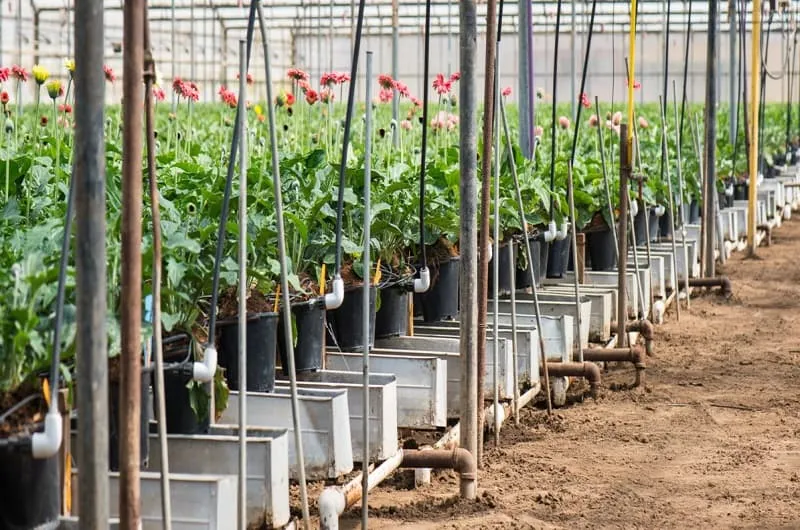
All these plants can handle the consistent moisture levels found in hydroponic systems without succumbing to root rot or other water-related issues. They can adapt to the nutrient solutions used in hydroponic systems and don’t require complex nutrient regimens.
Advanced Hydroponic Plants
Advancing in hydroponic gardening opens up a world of diverse plant options that can yield impressive results. While these plants may require more attention and care, your hard work will be rewarded with unique flavors and stunning visuals.
Challenging Vegetables and Fruits
When you’re ready to step up your hydroponic game, consider trying your hand at growing root vegetables like carrots and potatoes, which might test your skills as they normally require a medium like sand or perlite to support their growth and need careful timing for harvest.
Exotic Herbs and Spices
While many herbs are relatively easy to grow hydroponically, some can present moderate challenges due to their specific growth requirements, sensitivity to environmental conditions, or susceptibility to pests and diseases. Here are a few herbs that might be considered moderately difficult to grow hydroponically, especially for those without much experience:
- Dill: Dill has a tendency to bolt (flower and go to seed) if it’s not grown under optimal conditions. It requires careful management of light and temperature.
- Tarragon: French tarragon, which is the variety most prized for its flavor, can be more challenging to propagate and grow compared to other herbs. It can be sensitive to overly wet conditions and may require careful water management.
- Chives: While not particularly difficult to grow, chives can take time to establish from seed and may not produce as quickly as other herbs. They also prefer cooler temperatures and can be sensitive to high heat.
- Sage: Sage can be prone to root rot in hydroponic systems if the water is not well-oxygenated or if the system does not allow for sufficient drainage.
Flowering Plants and Ornamentals
If you’re leaning towards beauty in your hydroponic venture, flowers such as carnations can be quite rewarding. They have an extended blooming time with controlled lighting schedules. Hydroponic flowers, in general, are an attractive option for growers looking to achieve longer blooming periods and potentially better flower quality.
Specialty Fruits and Berries
Growers with a passion for sweet rewards might opt for specialty fruits and berries like watermelon, melons, and grapes. These crops generally take more time and space to produce fruit, but growing them hydroponically can yield impressive, high-quality produce.
- Watermelon and Melons: Require vigilant nutrient management and support structures for vines.
- Grapes: Can be a long-term project needing careful pruning and trellising.
Scaling Up Your Hydroponic System
When you find success in growing plants hydroponically, you might consider expanding your setup. Let’s explore how you can transform a small-scale hobby into a commercial endeavor and maximize the yield and diversity of your crops.
From Hobby to Commercial
Transforming your personal hydroponic garden into a commercial operation involves careful planning. As you upgrade, consider the space requirements of a greenhouse to accommodate a larger number of plants. You’ll also need to evaluate the financial aspects, from the cost of living plants to the necessary equipment for a commercial hydroponic farm. Scaling up means more than just growing; it means managing, marketing, and selling your produce. Finding the best plants for indoor hydroponics that are in high demand could give you a profitable edge.
- Financial Planning: Break down the costs of expanding, including equipment, seeds, nutrients, and labor.
- Space Planning: Consider the size of the greenhouse and the layout for maximum plant density.
- Market Research: Identify which vegetables or herbs have the highest demand in your target market.
- Regulatory Compliance: Ensure you meet all regulations and obtain any necessary certifications for commercial farming.
Maximizing Yield and Diversity
In the pursuit of higher yields, your focus should be on perfecting environmental conditions and choosing crops that flourish together. Vegetables are often a good choice for hydroponic farming due to their relatively easy vegetable growth patterns and compatibility with hydroponic systems. By diversifying the types of crops you grow, you can not only maximize space but also market appeal. Monitor and adjust nutrient solutions and lighting to ensure each of your greenhouse crops receives the care it needs for optimal growth.
- Crop Selection:
- Leafy greens – high turnover, easy to grow.
- Tomatoes – popular, can be grown year-round.
- Herbs – require less space, high value.
- Environmental Control:
- Nutrient levels – essential for plant health.
- Lighting – critical for photosynthesis, especially in the absence of natural light.
- Harvesting Strategy:
- Sequential planting – for continuous yield.
- Harvest cycles – tailored to each plant’s growth rate.
Scaling up your hydroponic system to meet commercial demands requires thorough planning and a willingness to adapt. By prioritizing crop selection and greenhouse management, you can successfully transition from hobby to commercial hydroponic farming.

